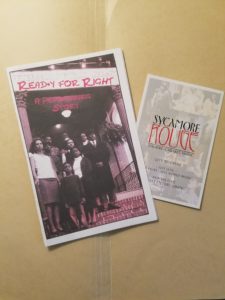(Note: This post was authored by Taylor McNeilly, Processing & Reference Archivist.) There are many different tasks included in archival processing, many of which non-archives professionals may not really think about at all. Of course there’s the organization, the foldering, the putting everything into boxes. But one of the most interesting parts of processing a collection for me is coming across evidence of the donor’s cultural legacy and getting to research that legacy. I’d like to take this week’s #WyattWalkerWednesday to explore one such remnant of cultural impact from the Dr. and Mrs. Wyatt Tee Walker Collection: a play put on about Dr. Walker and his civil rights work in Virginia.
Included in the collection is a program for the play “Read*y for Right: A Petersburg Story.” Without a page of copyright information like you’d find in a book, it can be hard to place something like this geographically or chronologically. Luckily, the theater staging this production was large enough (and modern enough) to have had an online presence, which makes placing it geographically pretty easy — turns out it was in nearby Petersburg. (You might have guessed that from the title, but archivists like to confirm that anyway.) Their online presence also shows that they are unfortunately closed, which cuts off one obvious avenue for questions. This makes placing it chronologically take a little more work.
To figure out when this play was put on, the easiest thing to do is search the program itself for context clues. We can tell by the style and quality of printing that it was most likely in the 21st century, but what can we tell from the information printed? What companies are placing ads? Do any of those have dates on them? It turns out one advertisement lists an event happening on “Saturday, October 25.” So let’s check to see what years October 25th fell on a Saturday and use those as a starting point. 2003, 2008, and 2014 are the most recent years that had a Saturday, October 25th. Since the theater, Sycamore Rouge, seems to have closed in 2013, we know it has to be earlier than that — so not 2014. Their online presence, some of which is still available, only dates back to 2011 or so, which doesn’t help us eliminate either 2008 or 2003 as possibilities.
Next, let’s look at some of the information given in the main text of the program. The message from the director doesn’t mention which season they’re in, and the timeline for her tenure is a bit vague. Looking at the list of actors and their biographies, however, we discover that the actor who played Dr. Walker is performing the role as his first with this company. Can we dig up any information about him?
While there’s plenty of information about this actor’s more recent roles (it seems he moved to Washington, DC), there’s not much to help in dating the show. What else can we find in the program to help us? And that’s when we hit gold! The Lighting Designer and Scenic Designer’s bios both mention work done in 2007, meaning this program must have been printed in ’07 or later. This, combined with the advertisement for “Saturday, October 25,” must mean that the show was put on in 2008. And to confirm this, the last page is a listing of Sycamore Rouge’s 2008-2009 season’s remaining shows, starting with December. On its own, this listing can’t confirm much, but combined with the information we picked up as we looked through the program, we know it must be 2008.
You can see how much work a single item in an archival collection may need, but this information is very helpful to archival staff in understanding the connections between the different items in the collection, as well as their connections to the donor. This can help us better serve researchers by providing access to materials we know are connected that the researcher may not be aware of when first coming in. And the information is also very helpful for researchers who come to use the collection, so we try our best to figure out as much as we can to help them along.
That’s it for this week’s #WyattWalkerWednesday post. As always, I’ll be back with a new glimpse into the processing of the collection next week. And in the meantime, feel free to follow the library’s Facebook, Instagram, and Twitter accounts for more updates from around Boatwright.

